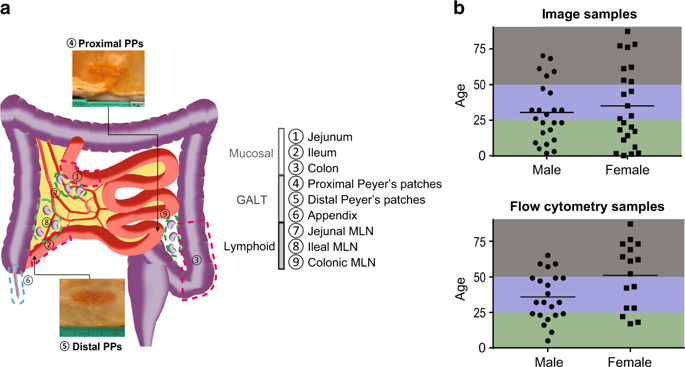当前位置:
X-MOL 学术
›
Mucosal Immunol.
›
论文详情
Our official English website, www.x-mol.net, welcomes your feedback! (Note: you will need to create a separate account there.)
Microanatomical dissection of human intestinal T-cell immunity reveals site-specific changes in gut-associated lymphoid tissues over life.
Mucosal Immunology ( IF 8 ) Pub Date : 2018-12-06 , DOI: 10.1038/s41385-018-0110-8 Takashi Senda 1, 2 , Pranay Dogra 1, 3 , Tomer Granot 1, 3, 4 , Kazuhiro Furuhashi 1 , Mark E Snyder 1, 3 , Dustin J Carpenter 1, 2 , Peter A Szabo 1, 3 , Puspa Thapa 1, 3 , Michelle Miron 1, 5 , Donna L Farber 1, 2, 5
Mucosal Immunology ( IF 8 ) Pub Date : 2018-12-06 , DOI: 10.1038/s41385-018-0110-8 Takashi Senda 1, 2 , Pranay Dogra 1, 3 , Tomer Granot 1, 3, 4 , Kazuhiro Furuhashi 1 , Mark E Snyder 1, 3 , Dustin J Carpenter 1, 2 , Peter A Szabo 1, 3 , Puspa Thapa 1, 3 , Michelle Miron 1, 5 , Donna L Farber 1, 2, 5
Affiliation

|
Defining adaptive immunity with the complex structures of the human gastrointestinal (GI) tract over life is essential for understanding immune responses to ingested antigens, commensal and pathogenic microorganisms, and dysfunctions in disease. We present here an analysis of lymphocyte localization and T cell subset composition across the human GI tract including mucosal sites (jejunum, ileum, colon), gut-associated lymphoid tissues (isolated lymphoid follicles (ILFs), Peyer's patches (PPs), appendix), and mesenteric lymph nodes (MLNs) from a total of 68 donors spanning eight decades of life. In pediatric donors, ILFs and PP containing naïve T cells and regulatory T cells (Tregs) are prevalent in the jejunum and ileum, respectively; these decline in frequency with age, contrasting stable frequencies of ILFs and T cell subsets in the colon. In the mucosa, tissue resident memory T cells develop during childhood, and persist in high frequencies into advanced ages, while T cell composition changes with age in GALT and MLN. These spatial and temporal features of human intestinal T cell immunity define signatures that can be used to train predictive machine learning algorithms. Our findings demonstrate an anatomic basis for age-associated alterations in immune responses, and establish a quantitative baseline for intestinal immunity to define disease pathologies.
中文翻译:

对人类肠道 T 细胞免疫的显微解剖揭示了肠道相关淋巴组织在一生中的位点特异性变化。
用人类胃肠道 (GI) 的复杂结构来定义适应性免疫,对于理解对摄入抗原、共生微生物和病原微生物以及疾病功能障碍的免疫反应至关重要。我们在此对人类胃肠道的淋巴细胞定位和 T 细胞亚群组成进行分析,包括粘膜部位(空肠、回肠、结肠)、肠道相关淋巴组织(分离淋巴滤泡 (ILF)、派尔氏集结 (PP)、阑尾)和肠系膜淋巴结 (MLN),来自总共 68 名捐献者,年龄跨越 8 个十年。在儿科供体中,空肠和回肠中分别普遍存在含有幼稚 T 细胞和调节性 T 细胞 (Treg) 的 ILF 和 PP;这些频率随着年龄的增长而下降,与结肠中 ILF 和 T 细胞亚群的稳定频率形成对比。在粘膜中,组织驻留记忆 T 细胞在儿童时期发育,并以高频率持续到老年,而 GALT 和 MLN 中的 T 细胞组成随年龄而变化。人类肠道 T 细胞免疫的这些空间和时间特征定义了可用于训练预测机器学习算法的特征。我们的研究结果证明了与年龄相关的免疫反应变化的解剖学基础,并建立了肠道免疫的定量基线来定义疾病病理。
更新日期:2019-01-26
中文翻译:

对人类肠道 T 细胞免疫的显微解剖揭示了肠道相关淋巴组织在一生中的位点特异性变化。
用人类胃肠道 (GI) 的复杂结构来定义适应性免疫,对于理解对摄入抗原、共生微生物和病原微生物以及疾病功能障碍的免疫反应至关重要。我们在此对人类胃肠道的淋巴细胞定位和 T 细胞亚群组成进行分析,包括粘膜部位(空肠、回肠、结肠)、肠道相关淋巴组织(分离淋巴滤泡 (ILF)、派尔氏集结 (PP)、阑尾)和肠系膜淋巴结 (MLN),来自总共 68 名捐献者,年龄跨越 8 个十年。在儿科供体中,空肠和回肠中分别普遍存在含有幼稚 T 细胞和调节性 T 细胞 (Treg) 的 ILF 和 PP;这些频率随着年龄的增长而下降,与结肠中 ILF 和 T 细胞亚群的稳定频率形成对比。在粘膜中,组织驻留记忆 T 细胞在儿童时期发育,并以高频率持续到老年,而 GALT 和 MLN 中的 T 细胞组成随年龄而变化。人类肠道 T 细胞免疫的这些空间和时间特征定义了可用于训练预测机器学习算法的特征。我们的研究结果证明了与年龄相关的免疫反应变化的解剖学基础,并建立了肠道免疫的定量基线来定义疾病病理。



























 京公网安备 11010802027423号
京公网安备 11010802027423号